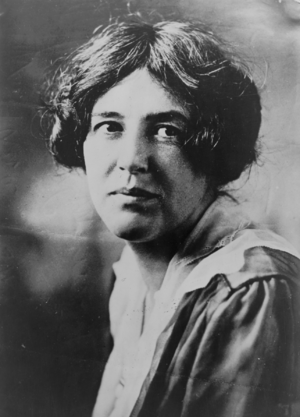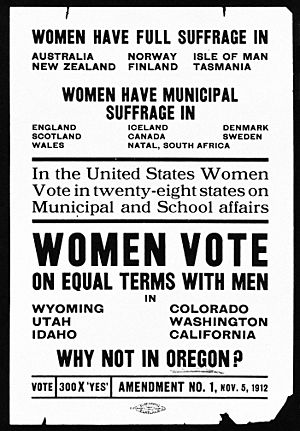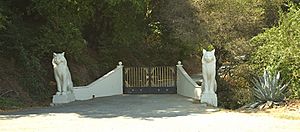Sara Bard Field facts for kids
Quick facts for kids
Sara Bard Field
|
|
|---|---|

Field, around 1915
|
|
| Born | September 1, 1882 |
| Died | June 15, 1974 (aged 91) |
| Nationality | American |
| Other names | Sara Ehrgott |
| Occupation | Poet Suffragist |
| Spouse(s) | Albert Ehrgott (c. 1900–1914) Charles Erskine Scott Wood (1938–1944) |
Sara Bard Field (born September 1, 1882 – died June 15, 1974) was an American poet and a strong supporter of women's right to vote. She also believed in fairness for everyone and helping those in need.
Sara worked hard to help women gain the right to vote in Oregon and Nevada. In 1915, she drove across the country from California to Washington, D.C. She carried a special paper with 500,000 signatures. This paper asked President Woodrow Wilson to support a law giving women the right to vote across the whole country. Sara was known for being a great speaker. Later in her life, she became a poet and married her long-time partner, C.E.S. Wood, who was also a poet and lawyer.
Sara's Early Life
Sara Bard Field was born in Cincinnati, Ohio, on September 1, 1882. Her mother came from a Quaker family, and her father was a strict Baptist. In 1885, her family moved to Detroit, Michigan. Sara finished high school in Detroit in 1900.
In September 1900, she married Albert Ehrgott, who was a minister. They traveled together to India and Rangoon, Burma. Sara had a son named Albert Field in 1901. She faced health challenges after childbirth. In 1902, she returned to the United States, and her family settled in New Haven, Connecticut.
In 1903, the Ehrgotts moved to Cleveland, Ohio. Sara was interested in ideas about helping others and making society fairer. She started a kindergarten (a school for young children) and a soup kitchen (where food is given to people in need). She met important people who were working to improve society, like Cleveland mayor Tom L. Johnson. Her sister, Mary Field, introduced her to lawyer Clarence Darrow. Sara had a daughter, Katherine Louise, in 1906. Sadly, her son passed away in an accident in 1918. This was a very difficult time for her.
Fighting for Women's Right to Vote
After their daughter was born, the Ehrgotts moved to Portland, Oregon, in 1910. Sara met C.E.S. Wood through Clarence Darrow. They became good friends, and she helped him with his writing. Their friendship grew very strong.
Sara joined the Oregon College Equal Suffrage League. She continued the work of Abigail Scott Duniway, who was also fighting for women's right to vote in Oregon. Sara traveled around the state in 1911, giving speeches to encourage people to support women's suffrage. That fall, she worked as a reporter for the Oregon Daily Journal. She covered a big trial about the Los Angeles Times bombing. She toured Oregon again in 1912, and her marriage faced difficulties.
From 1913 to 1914, Sara lived in Nevada to get a divorce. While there, she also worked to help women get the right to vote in Nevada. She was granted a divorce in November 1914 and started using her maiden name again. Her former husband was given custody of their children, and he moved to Berkeley, California. Sara moved to San Francisco to be closer to her son and daughter.
Sara became very involved in the national movement for women's right to vote. She joined the National Woman's Party. In 1915, she took part in suffrage events at the Panama-Pacific International Exposition (a big fair) in San Francisco. A leader named Alice Paul chose Sara and another suffragist, Frances Jolliffe, for an important mission. They were to drive across the country to deliver a petition to President Woodrow Wilson. This petition asked for a law to give women the right to vote across the U.S.
Sara, Frances, and two Swedish women started their trip from San Francisco on September 16, 1915. Frances had to leave the car for a while due to illness but rejoined the group later. Another suffragist, Mabel Vernon, traveled ahead by train. She organized parades and meetings to get attention for the trip and the cause. Newspapers across the country reported on their journey. The group finished their trip on December 6, 1915, and gave the petition to President Woodrow Wilson in Washington, D.C..
Sara spoke at a big meeting of the National Woman's Party in Chicago in 1916. She also supported Anne Henrietta Martin when Martin ran for the U.S. Senate in Nevada. Sara even came up with a famous slogan for the suffragists: "No votes, no babies!" In 1917, Sara helped a wealthy woman named Alva Belmont write her life story. In 1921, Sara represented the National Woman's Party. She helped present a statue about women's rights to the U.S. Congress. This statue is now in the Capitol Rotunda.
Later Life and Poetry
After 1918, Sara Bard Field lived with lawyer and poet Charles Erskine Scott Wood in San Francisco. Sara focused on her poetry. They often welcomed local artists to their home. These artists included Genevieve Taggard, Benny Bufano, and George Sterling. Wood was wealthy, and they used their money to support artists and important causes.
In 1923, Sara moved with Wood to a large estate called "The Cats" in Los Gatos, California. It was a big property, about 30 acres.
Sara's first book of poems, The Pale Woman, was published in 1927. In 1932, she published a long poem called Barabbas. This poem won her a gold medal from the Book Club of California. Her second collection of poems, Darkling Plain, came out in 1936.
After his wife passed away, Wood married Sara in 1938. Wood died in 1944. In 1955, Sara moved to Berkeley to be closer to her daughter. Sara Field passed away on June 15, 1974, from heart disease.
Selected Works



